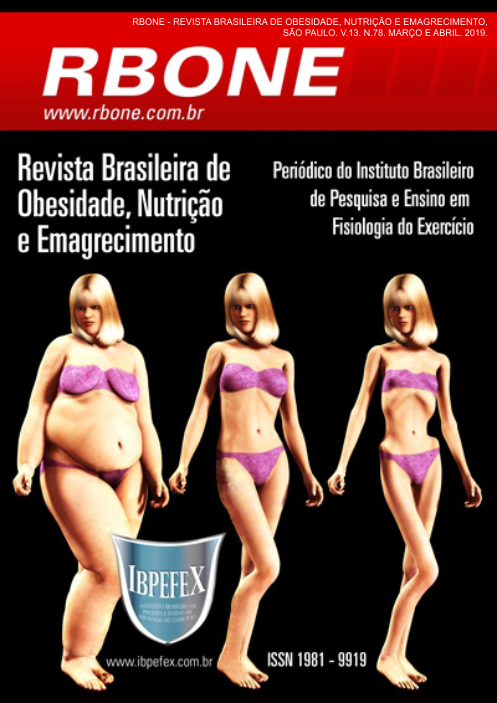Nutritional status of newborns with microcephaly
Abstract
Introduction: Microcephaly is a pathological condition in which the brain compartments do not develop properly, and may be caused by genetic, viral, environmental and nutritional factors. The present study covers a sample of newborns affected by Microcephaly, whose etiological factor was the Zíca Virus. Objective: To describe the profile of the sample studied by gender, gestational age, type of delivery, cephalic perimeter, and to investigate the nutritional status of the newborn through anthropometric variables. Methods: This was a descriptive, retrospective, quantitative study with the use of anthropometric parameters to investigate the nutritional profile of 35 newborns at the Integrated Rehabilitation Center in Teresina PI, Brazil. Results and Discussion: Regarding their characteristics, the gender with the highest prevalence was female, with 65.7%, with 82.9% being born at term between 37-41 weeks of gestational age with a mean of 38.3 weeks (IC95 % 37.6-39.0), 62.9% of whom were born Caesarian. According to the measurement of the anthropometric data of the newborn, we found the mean of 30.0 cm for the Cephalic Perimeter (IC95% 29.0-30.9), while the length at birth obtained a mean of 45.2 cm 95% CI 44.0-46.4), and birth weight with a mean of 2616.6 g (95% CI 2426.0-2807.20). The anthropometric indexes that showed the highest proportions were: Weight-for-height, indicating that 57.2% of the newborns were at risk of overweight. And the body mass index for age was 62.9%, indicating a risk of overweight. Conclusion: The literature reports that the reduced cerebral compartment results in the decrease of the total body weight due to the involution of the brain. However, it was observed that the newborns presented risk of overweight, which worries and differs from the literature.
References
-Accioly, E.; Saunders, C.; Lacerda, E. M. A. Nutrição em Obstetrícia e Pediatria. 2ªedição. Guanabara. 2009.
-Costa, I.; Custódio, M.; Coutinho, V.; Liberali R. Terapia Nutricional em doenças neurológicas. Neurociência.2010.
-Kamimura, M. A.; Baxmann, A.; Sampaio, L.R.; Cuppari, L. Avaliação nutricional. In: Cuppari, L. Guia de medicina ambulatorial e hospitalar Unifesp/ Escola paulista de medicina -Nutrição clínica no adulto. Barueri, S.P: Manole. p. 71-98. 2002.
-Lima, A.C.G.; Oliveira, M.C.; Avaliação Nutricional de Pacientes Neurológicos submetidos à Terapia Nutricional Enteral em uma Unidade de Terapia Intensiva. Rev. Bras. Nut. Clin. Vol. 31. Num. 2. p. 112-117. 2016.
-Magno, M. A. C. B.; Rocha, N. P. Saúde da gestante e do feto: ingestão de micronutrientes essenciais versus utilização das substâncias prejudiciais. HU Revista: Juiz de Fora-MG. Vol. 37. Num. 4. p. 441-448. 2011.
-Ministério da Saúde. Secretaria de Atenção à Saúde -Departamento de Atenção Básica. Orientações para a coleta e análise de dados antropométricos em serviços de saúde: Norma Técnica do Sistema de Vigilância Alimentar e Nutricional -SISVAN. Brasília: 2011. 76 p. il. –Série G. Estatística e Informação em Saúde.
-Ministério da Saúde. Plano Nacional de Enfrentamento á Microcefalia. 2016.
-Ministério da Saúde. Saúde da criança: Aleitamento Materno e Alimentação Complementar. Núm. 2. 2015.
-Mussoi, T. D. Avaliação Nutricional na prática clínica Da gestação ao Envelhecimento. Rio de Janeiro: Guanabara Koogan. 2014.
-Nobrega, R. V. Secretaria Executiva de Vigilância em Saúde, Secretaria Estadual de Saúde. Possível alteração do padrão de ocorrência de microcefalia em nascidos vivos no Estado de Pernambuco. Nota Técnica. 2015.
-Nunes, M.L.; Carlini, C. R.; Marinowic, D.; Neto, F. K.; Fiori, H. H.; Scotta, M. C.; Zanella, P. L. A.; Soder, R. B.; Costa, J. C. Microcephaly and Zika virus:a clinical and epidemiological analysis of the current outbreak in Brazil. Jornal de Pediatria. Num. 92. p. 230-240. 2016.
-Sequeira, J. M.; Desai, A.; Zaragoza, M. I. B.; Murphy, M.M.; Ballart, J. D. F.; Quadros, E. V. Exposure to Folate Receptor Alpha Antibodies during Gestation and Weaning Leads to Severe Behavioral Deficits in Rats: A Pilot Study. PLOS ONE. 2016.
-Souza,A.S.R.; Souza, A. I.; Faquin, S. L. L.; Neto, O. G. S.; Honorato, E.; Mattos, A. G. L.; Holanda, S. C.; Figueiroa, J. N.; Schettini, J. Alterações Ultrassonográficas Intraútero, crescimento da circunferência cefálica fetal e desfechos neonatais entre casos presumíveis de Síndrome da Zica congênita no Brasil. Rev. Bras. Saúde Materno Infantil. Recife-PE. Vol. 16. Supl. 1. p. S17-S25. 2016a.
-Souza, W. V.; Araújo, T. V. B.; Albuquerque, M. F. P. M.; Braga, M. C.; Ximenes, R. A. A.; Filho, D. B. M.; Bezerra, L. C. A.; Dimech, G. S.; Carvalho, P. I.; Assunção, R. S.; Santos, R. H.; Oliveira, W. K.; Rodrigues, L. C.; Martelli, C. M. T. Microcefalia no Estado de Pernambuco, Brasil: características epidemiológicas e avaliação da acurácia diagnóstica dos pontos de corte adotados para notificação de caso. Cad. Saúde Pública. Rio de Janeiro. Vol. 32. Num. 4. p.e00017216. 2016b.
-Texeira, D.; Pestana, D.; Calhau, C.; Vicente, L.; Graça, P. Alimentação e nutrição na gravidez: Programa Nacional para a Promoção da Alimentação Saudável Direção-Geral da Saúde. 2015.
-Tourinho, A. B.; Reis, L. B. S. M. Peso ao Nascer: Uma abordagem Nutricional. Com. Ciências Saúde. Vol. 22. Num. 4. p.19-30. Brasília-DF: Brasil, 2013.
Authors who publish in this journal agree to the following terms:
- Authors retain the copyright and grant the journal the right of first publication, with work simultaneously licensed under the Creative Commons Attribution License BY-NC which allows the sharing of the work with acknowledgment of the authorship of the work and initial publication in this journal.
- Authors are authorized to enter into additional contracts separately for non-exclusive distribution of the version of the work published in this journal (eg, publishing in institutional repository or book chapter), with acknowledgment of authorship and initial publication in this journal.
- Authors are allowed and encouraged to post and distribute their work online (eg, in institutional repositories or on their personal page) at any point before or during the editorial process, as this can bring about productive change as well as increase impact and impact. citation of published work (See The Effect of Free Access).






